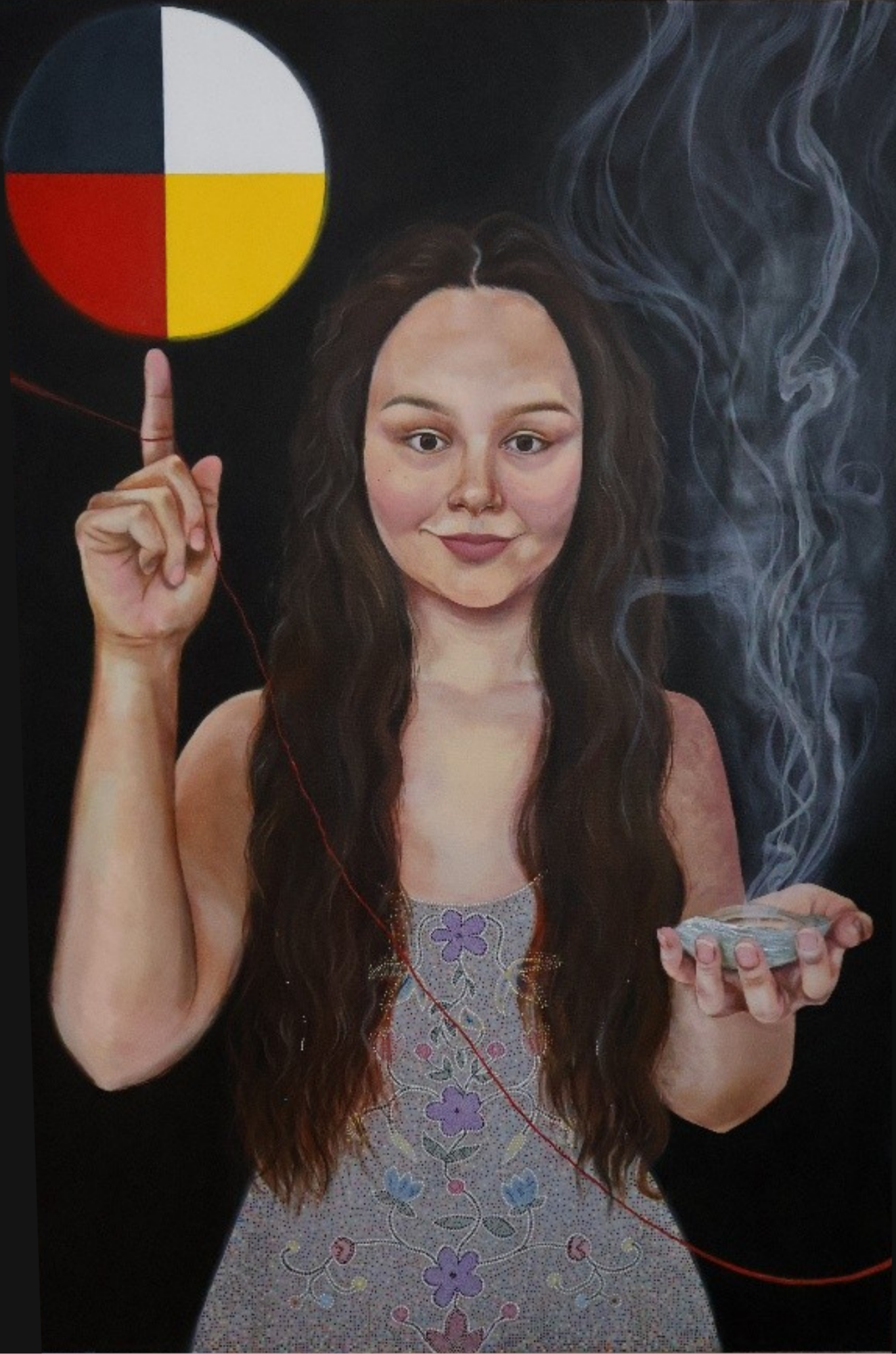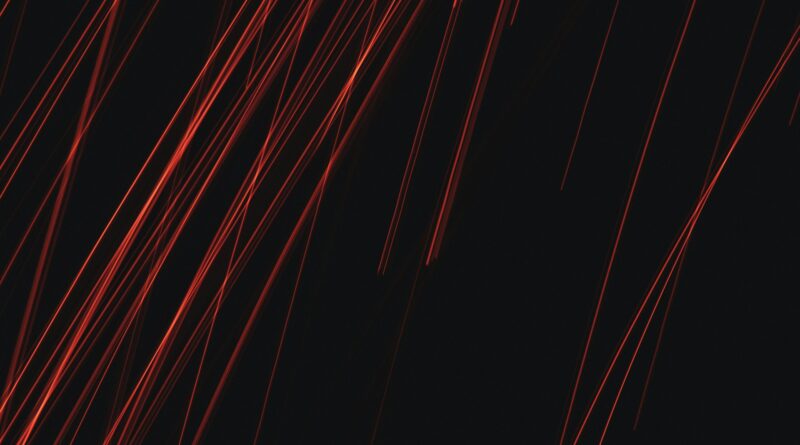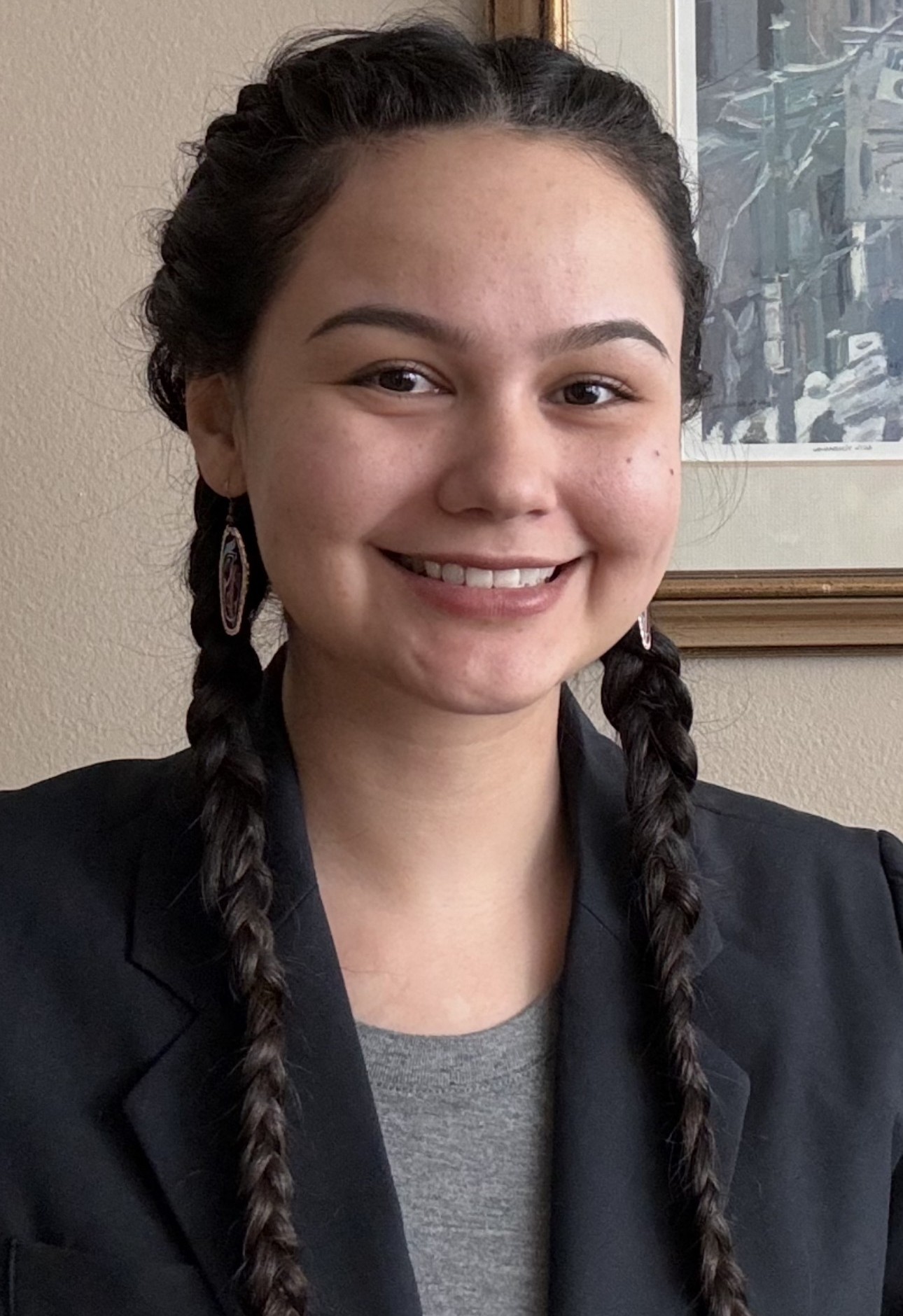Looping the Red Thread of Information: Painting a Path of Indigenous Knowledge
Looping the Red Thread of Information: Painting a Path of Indigenous Knowledge
Jasmine Wemigwans
As a mixed Ojibwe woman from Wiikwemkoong Unceded Territory, I carry both pride and a sense of responsibility in how I represent my identity through academic and artistic spaces. I recently graduated from the Master of Information in Library Science Program at the University of Toronto’s Faculty of Information. My goal is to become a full-time librarian who integrates Indigenous knowledge into library and information systems. I am excited to share my painting with the Information Matters community as one way to contribute an Indigenous perspective in our shared field. This acrylic self-portrait, funded by an Ontario Arts Council bursary, reflects the concept of the “Red Thread of Information” (Bates,1999) and visually embeds my Anishnaabe worldview. The piece invites viewers to reflect on how identity and information phenomenon can be fused together into creative expressions.

Throughout my studies, I have noticed how few academic syllabi included Indigenous voices, often defaulting to what Eve Tuck (2009) calls “damage-centered research.” As a young, mixed, first-generation student, I found that Indigenous worldviews were often reduced to trauma narratives. Tuck (2009) calls for a shift, that moves towards showcasing the vibrancy and brilliance of Indigenous communities without erasing our truths. Her message resonates deeply with me. I have also been inspired by the words of Rigoberto Lara Guzmán et al. (2019), who write that “by spreading shine we can build distributed networks and reinforce community through mutual aid.” Academic writing can reflect these values when it uplifts stories of resilience and joy. I try to practice this through the topics I choose and the voices I cite, to bring a positive approach to all the things I create.
—The red thread tugging on my finger in the painting symbolizes how I am being called to listen more closely to my intuition and ancestral guidance.—
This painting took over two years to complete, growing alongside my academic journey. I used discontinued Stevenson Professional Paints, especially the raw sienna colour for the underpainting, paired with a grid method to map my features from a reference photo. As a young Indigenous woman navigating the layered effected of colonization, I felt that painting gives me peace. The black background, which is done in Ivory Black by Liquitex brand, is supposed to represent the challenges I faced. The slightly different Mars Black by Liquitex forms the medicine wheel quadrant, a meaningful symbol that grounded me. My dress symbolizes Ojibwe femininity and floral woodland art, inspired by Christi Belcourt’s Wisdom of the Universe (2014). The colourful fill resembles both “bead soup” patterns and glass gem corn, linking to the sacred Anishnaabe story of the “Three Sisters,” particularly Maize.
This painting also served as a creative submission for the course at the Faculty of Information, Remix Culture, taught by Professor Seamus Ross. The concept of remixing, as described by Martin Irvine (2015), is a generative process that is a sort of layering that builds something new through thoughtful recombination. One of the best metaphors for remixing I believe did not come from academia, but from pop culture. In Shrek (2001), the ogre says “Orges are like onions. Onions have layers.” Donkey responds with, “Not everybody likes onions.” That exchange reflects the remix process perfectly, how it is layered and sometimes messy, plus not always universally appreciated, but deeply personal and culturally revealing. This conversation between Shrek and donkey signifies how we can be influenced by many different mediums, that we then internalize, which allows us to create something juxtaposed or aligned in harmony to the “original.” Donkey’s message also reflects different people’s tastes and preferences to remixed recreations or unravelling the “onion” to its core or essence. I see remixing as a method that mirrors identity itself, it is complex and always evolving and it is constructed through both tradition and reinterpretation. Robert Sternberg (2018) theorizes that creativity involves defying your former self and evolving past old belief. My piece is a revisitation of a high-school self portrait from several years ago. This time, I fully committed to realism and blended it with Ojibwe beadwork-inspired pointillism. The University of Toronto iSchool’s openness to creative academic work gave me space to push my artistic and intellectual boundaries. I submitted this painting’s work in progress, alongside an essay submission for my Remix Culture class.
A key element in my painting is my gesture toward the red quadrant of the medicine wheel. According to Elder Lillian Pitawanakwat, the southern direction teaches us to care for our spirits and trust our intuition:
“The southern direction reminds us to look after our spirits. When you are in balance within yourself, spirit will warn you of danger, it will tell you, ‘No, don’t go there. Go this way instead.’ So, no matter what happens, when you listen to that spirit, to that intuition, it never deceives you.”
When I began the painting, I pointed toward red with a sense of pride, believing I had reached a stage of growth and adulthood. But over time, I came to see that the red also symbolized the pain and anger I carried from personal struggles, especially those rooted in adolescence and early adulthood. Pitawanakwat’s teaching reframed that gesture for me. It is not a declaration of having arrived at adulthood, but as a call to continue learning and healing. Her words reminded me that spiritual maturity is not fixed, it is a lifelong practice of returning to balance. This painting now feels like a layered expression of both emotional honesty and ancestral guidance, capturing the tension between who I thought I was and who I am still becoming.
To my surprise, red is an important symbolic color in Information Science, too. The concept of the “Red Thread of Information” came to me through Marcia Bates (1999) and was expanded on in Jenna Hartel’s Information Experience course, which is a required course in the Library and Information Science (LIS) concentration at the iSchool (Toronto). Bates describes the red thread as the core informational storyline that information professionals seek to understand and facilitate within the social fabric of people’s lives. Hartel adds depth to this metaphor by connecting it to global narratives such as Chinese and Greek legends, as well to visual research on how people conceptualize information. In my culture, red thread appears in tobacco ties and medicine bundles. The red thread tugging on my finger in the painting symbolizes how I am being called to listen more closely to my intuition and ancestral guidance. I designed it to point toward the medicine wheel, which represents wholeness, balance and healing in Ojibwe teachings. This colorful metaphor resonated with me, as it tied together my academic learning, cultural teachings, and personal growth. Through painting and writing, I tried to make this abstract idea tangible.
This painting was also inspired by Leonardo DaVinci’s Saint John the Baptist (1515), but reimagined with Indigenous symbols, such as the abalone shell, White Sage smoke, and hidden ancestral faces. I also included the medicine wheel’s four colours: red, yellow, black and white which speak to the teachings I grew up with in Toronto. This tribute extends to artists like Kent Monkman, whose work indigenizes classical European painting styles.
My painting also acknowledges the broader systemic barriers Indigenous people have faced in accessing higher education. In 1967, only 200 Indigenous students were enrolled in Canadian universities representing less than 1% of the Indigenous student population (McCue, 2011). While progress has been made, Indigenous representation in fields like STEM remains disproportionately low (Statistics Canada, 2023). In libraries, whiteness and colonial legacies persist. Schlesselman-Tarango (2016) critiques the “lady bountiful” archetype of white librarianship and how libraries historically participated in assimilationist projects. These insights helped me better understand how to situate myself within the LIS field, I wish to continue challenging norms and centering Indigenous perspectives where they are needed most. For example, it would be a wonderful opportunity in the future to work with Indigenous communities and re-classify information in ways that honor Indigenous experience.
Ultimately, this piece is a layered self-portrait that seeks to connect academic, spiritual, cultural and artistic threads of my journey. I hope that by sharing my self-portrait with Information Matters, encourages other folks across Information Science to express themselves creatively. I would like to say Chi-Miigwech (Thank you) to Information Matters to be willing to feature artistic expressions in their pages, and I look forward to more multimodal contributions in the future.
References
Adamson, A., & Jenson, V. (2001). Shrek. DreamWorks Distribution.
Hartel, J. (2020). The red thread of information. Journal of Documentation, 76(3), 647–656. https://doi.org/10.1108/JD-04-2019-0067
Irvine, M., Navas, E., Gallagher, O., & Burrough, X. (2015). Remix and the Dialogic Engine of Culture: A Model for Generative Combinatoriality. In The Routledge Companion to Remix Studies (1st ed., pp. 15–42). Routledge. https://doi.org/10.4324/9781315879994-3
McCue, H.A. (2011). Education of Indigenous Peoples in Canada. The Canadian Encyclopedia. https://www.thecanadianencyclopedia.ca/en/article/aboriginal-people-education
Pitawanakwat, Lillian. (2006-2012©). Ojibwe/Potawatomi (Anishinaabe) teaching of the Medicine Wheel. THE SOUTH – ZHAAWANONG.https://fourdirectionsteachings.com/transcripts/ojibwe.html
Rigoberto Lara Guzmán and Sareeta Amrute. (2019) How to Cite like a Badass Feminist Tech Scholar of Colour. Cite Black Barnard Faculty. https://citeblackbarnard.com/about/reading/how-to-cite-like-a-badass-tech-feminist-scholar-of-color-by-rigoberto-lara-guzmn-data-society-points
Robert J Sternberg. (2018). A triangular theory of creativity. Psychology of Aesthetics, Creativity, and the Arts, 12(1), pp.,50-67. https://doi.org/10.1037/aca0000095
Tuck, E. (2009). Suspending Damage: A Letter to Communities. Harvard Educational Review, 79(3), 409–427. https://doi.org/10.17763/haer.79.3.n0016675661t3n15
Schlesselman-Tarango, G. (2016). The Legacy of Lady Bountiful: White Women in the Library. Library Trends 64(4).
Statistics Canada. (2023, June 21). Major field of study (STEM and BHASE, summary) by Indigenous identity: Canada, provinces and territories, census metropolitan areas and census agglomerations with parts (Table 98‑10‑0416‑01). https://www150.statcan.gc.ca/t1/tbl1/en/tv.action?pid=9810041601
Cite this article in APA as: Wemigwans, J. (2025, August 6). Looping the red thread of information: Painting a path of indigenous knowledge. Information Matters. https://informationmatters.org/2025/08/looping-the-red-thread-of-information-painting-a-path-of-indigenous-knowledge/






